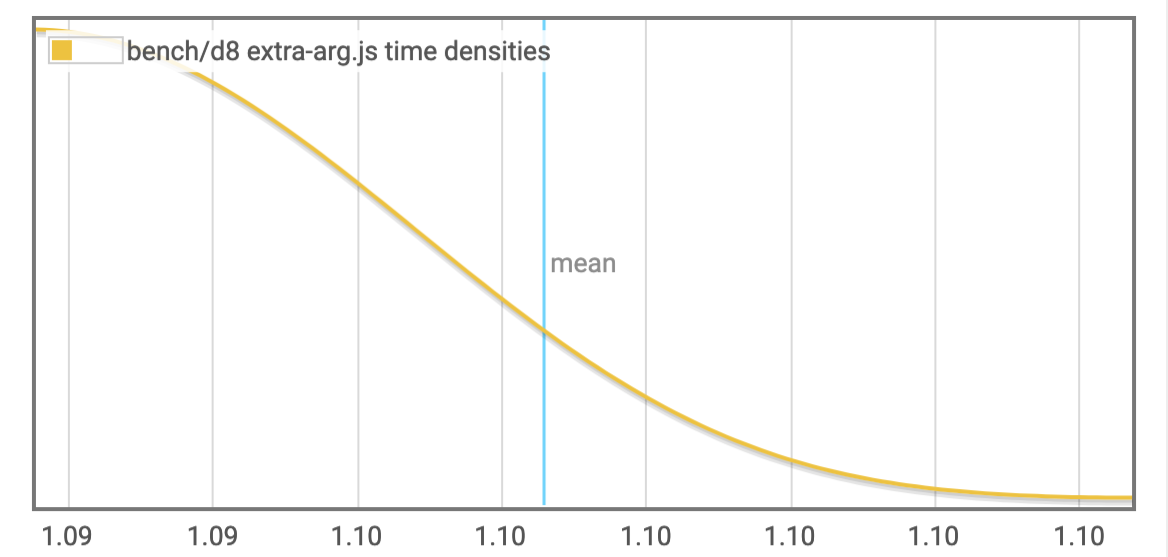V8 puzzle
Last week I randomly ran into a V8 behaviour I didn't expect.
Here is a Primes prototype:
function Primes() {
this.counter = 0;
this.primes = [];
this.getCounter = () => this.counter;
this.getPrime = (i) => this.primes[i];
this.push = (i) => this.primes[this.counter++] = i;
this.isPrime = (n) => {
for (var i = 1; i < this.counter; ++i) {
if ((n % this.primes[i]) == 0) return false;
}
return true;
}
}
2
3
4
5
6
7
8
9
10
11
12
13
14
As you can see, it doesn't take parameters. You would simply do new Primes(), not new Primes(2, ['foo', bar()], Math.random() * baz()).
Here is a main function using Primes to generate the n first prime numbers, putting them in a list:
function main(n) {
const p = new Primes();
let c = 1;
while (p.getCounter() < n) {
if (p.isPrime(c)) {
p.push(c);
}
c++;
}
print(p.getPrime(p.getCounter() - 1));
}
// and here is how I call it:
main(25000);
2
3
4
5
6
7
8
9
10
11
12
13
14
Now let's make two versions of this script. The only difference between the first version, normal.js, and the second version, extra-arg.js, is this one:
normal.jsfunction Primes() {
this.counter = 0;
this.primes = [];
this.getCounter = () => this.counter;
this.getPrime = (i) => this.primes[i];
this.push = (i) => this.primes[this.counter++] = i;
this.isPrime = (n) => {
for (var i = 1; i < this.counter; ++i) {
if ((n % this.primes[i]) == 0) return false;
}
return true;
}
}
function main(n) {
const p = new Primes();
let c = 1;
while (p.getCounter() < n) {
if (p.isPrime(c)) {
p.push(c);
}
c++;
}
print(p.getPrime(p.getCounter() - 1));
}
main(25000);
2
3
4
5
6
7
8
9
10
11
12
13
14
15
16
17
18
19
20
21
22
23
24
25
26
27
28
extra-arg.jsfunction Primes() {
this.counter = 0;
this.primes = [];
this.getCounter = () => this.counter;
this.getPrime = (i) => this.primes[i];
this.push = (i) => this.primes[this.counter++] = i;
this.isPrime = (n) => {
for (var i = 1; i < this.counter; ++i) {
if ((n % this.primes[i]) == 0) return false;
}
return true;
}
}
function main(n) {
const p = new Primes(null); /* ?! */
let c = 1;
while (p.getCounter() < n) {
if (p.isPrime(c)) {
p.push(c);
}
c++;
}
print(p.getPrime(p.getCounter() - 1));
}
main(25000);
2
3
4
5
6
7
8
9
10
11
12
13
14
15
16
17
18
19
20
21
22
23
24
25
26
27
28
❯ d8
V8 version 5.8.101
❯ make
time d8 normal.js
287107
1.21 real 1.18 user 0.02 sys
time d8 extra-arg.js
287107
1.07 real 1.04 user 0.01 sys
2
3
4
5
6
7
8
9
The extra-arg version consistently runs ~10% faster on v8 5.8.9and 5.8.101:

bench/d8 normal.js

| lower bound | estimate | upper bound | |
|---|---|---|---|
| OLS regression | xxx | xxx | xxx |
| R² goodness-of-fit | xxx | xxx | xxx |
| Mean execution time | 1.2244014127760094 | 1.2302440249237707 | 1.2336210836091757 |
| Standard deviation | 0.0 | 5.241324404964492e-3 | 5.849237223263123e-3 |
Outlying measurements have moderate (0.18749999999999997%) effect on estimated standard deviation.
bench/d8 extra-arg.js

| lower bound | estimate | upper bound | |
|---|---|---|---|
| OLS regression | xxx | xxx | xxx |
| R² goodness-of-fit | xxx | xxx | xxx |
| Mean execution time | 1.094407024081591 | 1.0972965331160693 | 1.0994041288091074 |
| Standard deviation | 0.0 | 3.19627481050371e-3 | 3.650462822155438e-3 |
Outlying measurements have moderate (0.18749999999999997%) effect on estimated standard deviation.
(Benchmark done using bench (opens new window), report generated by criterion (opens new window).)
As we can see, with 0 argument it's slow, with 1 it's fast. What happens as we keep adding more arguments? (List index is number of arguments.)
- fast
- slow
- fast
- fast
- slow
- fast
- fast
- slow
- fast
- slow
- fast
- fast
- slow
- fast
- fast
My attempts at understanding what's happening here failed. I really don't know the reason behind these differences.
I ran the two original versions, the one with zero argument and the one with one argument, using d8 built with debug options:
d8 \
--trace-hydrogen \
--trace-phase=Z \
--trace-deopt \
--code-comments \
--hydrogen-track-positions \
--redirect-code-traces \
--print-opt-code
2
3
4
5
6
7
8
Here are the generated files if you want to analyze them yourself:
If anyone can explain what happens here, please ping me on twitter _vhf (opens new window) or send me an email (contact@ this domain (draft.li)! I'll link to your explanation or include it here or rephrase it here.
The number of instructions fetched on a given cycle is dependent on multiple factors. For Intel's fourth generation Core processors, when using the instruction cache rather than the µop cache, an aligned 16 byte block of instructions are fetched each cycle.
To get a better understanding of why and how alignment matters, check out Agner Fog's the microarchitecture doc, esp. the section about the instruction-fetch front-end of various CPU designs.